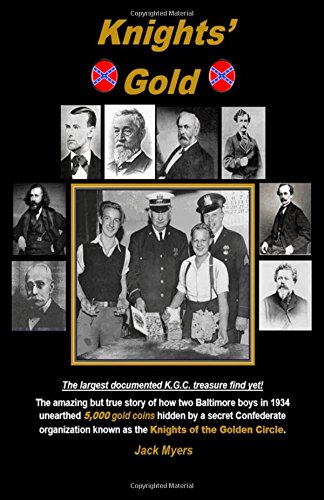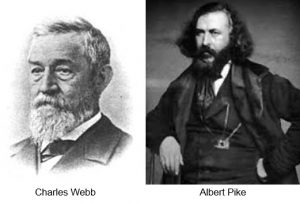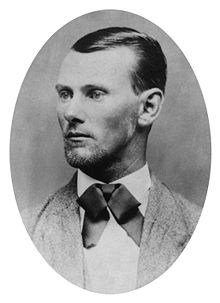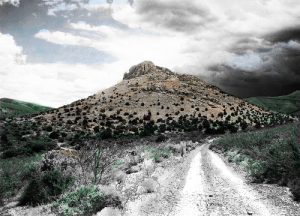
After first setting out to research and write a book about real kids finding real treasure, Jack Myers found himself exploring something significantly more entangled. He soon discovered there was a strong possibility a pot of 5000 gold coins, found in the 1930’s by two young boys, was not buried by the person often assumed, but by a highly secretive group with a dangerous agenda. Jack’s investigative work and conclusion is extensive, and incredibly persuasive.
I was impressed by how Jack presented his findings in his book, Knights’ Gold, and how he guided a reader through some of the most controversial times of our country. He outlines a remarkable path which leaves a reader to question what is known.
I was glad to catch up with him and ask him the following Six Questions about these found treasures, his book, and more. Enjoy!
Six Questions with Jack
- 1Q) I must first say, great research, Jack. And thanks for this opportunity to ask more about your book, Knights’ Gold. I enjoyed reading it very much. It seems your investigation for Knights’ Gold began when the story about the treasure hoard found on Eden Street, Baltimore, by two young boys in 1934 didn’t quite add up to you. What was it exactly that made you question the story and inspired you to dig deeper?
 First, Jenny, thanks so much for the compliments. I’m glad you enjoyed Knights’ Gold. In researching my children’s book, Treasure Kids!, I obtained a copy of Len Augsburger’s well-researched 2008 book Treasure in the Cellar. Before Knights’ Gold, Treasure in the Cellar had been the only book written about the 1934 Baltimore Gold Hoard. Len, a numismatist, believes that candle maker and real estate speculator Andrew Saulsbury was responsible for burying the 5,000 gold coins. He bases his belief on the fact that Saulsbury was wealthy and died unexpectedly in 1873 in the Baltimore treasure house. But the dates on the coins are a huge problem. The coins, all minted in the U.S., are from the years 1834-1856. Not a single coin was dated after 1856.
First, Jenny, thanks so much for the compliments. I’m glad you enjoyed Knights’ Gold. In researching my children’s book, Treasure Kids!, I obtained a copy of Len Augsburger’s well-researched 2008 book Treasure in the Cellar. Before Knights’ Gold, Treasure in the Cellar had been the only book written about the 1934 Baltimore Gold Hoard. Len, a numismatist, believes that candle maker and real estate speculator Andrew Saulsbury was responsible for burying the 5,000 gold coins. He bases his belief on the fact that Saulsbury was wealthy and died unexpectedly in 1873 in the Baltimore treasure house. But the dates on the coins are a huge problem. The coins, all minted in the U.S., are from the years 1834-1856. Not a single coin was dated after 1856.
Saulsbury did not buy the house and move in until June, 1865 — after the Civil War. Augsburger admits the coins were likely buried in 1856. Did Saulsbury bury them at his previous home on nearby Central Avenue and then re-bury the coins on Eden Street in 1865? The owner of the treasure house in 1856, a sea captain named John Mattison, sold the house to Saulsbury in 1865 and lived elsewhere for another ten years. Since no one would logically leave behind such a fortune in gold, Mattison has always been excluded from consideration as being the person responsible for burying the coins, even though the apparent 1856 burial date points directly at Captain Mattison and not Saulsbury.
Another sticking point was Saulsbury’s wealth. Yes, he died wealthy at age 46 in 1873, but in 1856 Saulsbury was still establishing himself in business and had a growing young family to support. I had trouble with the scenario of a 29-year old father amassing a fortune in 5,000 gold coins and burying them in his cellar in 1856, and then re-burying them in 1865 under his new home. Saulsbury did not have any mistrust of banks. In fact, he owned shares in the local savings & loan! In no way does young family man Saulsbury fit the image of an antisocial, paranoid miser burying gold coins in his basement.
The answer to the mystery was presented to me when I by chance watched an episode of Brad Meltzer’s Decoded about the Knights of the Golden Circle and their buried treasures. I realized that the 5,000 gold coins in the cellar may have been connected to the KGC, and therefore did not personally belong to either Captain Mattison or businessman Andrew Saulsbury. So when I began researching the backgrounds of these two men I immediately hit pay dirt. Mattison had been an illegal African slave trader, transporting slaves across the Atlantic to both Havana and Baltimore.
 And Saulsbury? The businessman was known far and wide as an “ardent Southern sympathizer.” He was an avid spokesperson and recruiter for the rebel cause. And both men were directly and intimately connected to Southern Democrat political kingmaker Charles Webb, who backed the anti-Lincoln secession movement in Baltimore and who, as the Grand Master of Marylander Freemasonry, was promoted to that position by none other than Albert Pike, the alleged mastermind behind the Knights of the Golden Circle.
And Saulsbury? The businessman was known far and wide as an “ardent Southern sympathizer.” He was an avid spokesperson and recruiter for the rebel cause. And both men were directly and intimately connected to Southern Democrat political kingmaker Charles Webb, who backed the anti-Lincoln secession movement in Baltimore and who, as the Grand Master of Marylander Freemasonry, was promoted to that position by none other than Albert Pike, the alleged mastermind behind the Knights of the Golden Circle.
So, the buried coins were the result of a conspiracy, and represented initiation fees and dues collected by the Baltimore chapter of the KGC. KGC dues and fees were often paid in gold coin, and that is exactly what we see in the treasure pot. The coins were collected at Saulsbury’s original house, the KGC recruiting station, and then for security purposes buried around the corner in Mattison’s cellar. After the war, when Captain Mattison sold his house to Saulsbury, the coins remained in the basement with Saulsbury retaining control of the money “against the day when the South shall rise again.” But there never was a second Civil War, and Saulsbury passed away suddenly from an unexpected illness.
-

Jesse James 2Q) From reading Knights’ Gold, I was amazed at the numerous historical characters becoming intimately linked. Notorious characters, like Jesse James, John Wilkes Booth, Albert Pike, and others. Were you surprised by this yourself? Or what did you find most surprising during your investigations?
Yes, I too was surprised — but that is where my research led me. Baltimore was a key city in the history of the Civil War, especially early on. The first blood of the Civil War was spilled on the streets of Baltimore during the April 19, 1861 riots opposing the movement of Union troops through Baltimore to defend Washington, D.C. Lincoln was opposed by the Southern Democrat politicians in Baltimore, who ultimately ordered the burning of Baltimore’s bridges so no more troop trains could pass.
Both the Mayor George Brown and Police Marshal George Kane of Baltimore had been installed with the help of Democrat kingmaker Charles Webb. Charles Webb ran Armstrong & Associates, maker of fine soaps and candles. His right hand man at the firm was Andrew Saulsbury, under whose home 5,000 gold coins would be unearthed. Another key executive was the founder’s nephew and Saulsbury’s best friend, Thomas Armstrong, who lived at the local “rebel” hotel, the Fountain Inn. Another 2,000 gold coins would later be unearthed when the Fountain Inn was demolished. Many rebel plans were hatched at the Fountain, and that establishment was the focus of Union spies infiltrating the Confederacy.
Marshal George Kane, Webb’s lifelong political ally, oversaw one of the rebel squads that burned Baltimore’s bridges in April, 1861. Anecdotal evidence suggests that one of Kane’s henchmen in burning bridges and tearing up track was a young actor named John Wilkes Booth. Booth’s family home in Baltimore was just four blocks from the Mattison/Saulsbury treasure house.
My biggest surprises during my investigation were:
- That John Wilkes Booth was likely inducted into the KGC in the home of Andrew Saulsbury. We know that Booth was supposedly inducted in “a home in his neighborhood.” Saulsbury’s home was just a few minutes’ walk from the Booth family home. Booth was allegedly made a member of the KGC in a private home with portraits and busts of Confederate heroes hanging on the walls. Later court records in the 1934-35 Baltimore treasure trial describe the Saulsbury home as having portraits of Confederate heroes adorning the parlor walls. The 5,000 gold coins, of course, lend further credence to Saulsbury having been the recruiter and dues collector for the Baltimore KGC.
- That if President-elect Lincoln had traveled down Pratt Street next to the Inner harbor at the appointed hour in February, 1861, he would likely have been assassinated directly in front of the offices of James Armstrong & Associates, makers of fine soaps and candles. Allan Pinkerton and other investigators, however, had sniffed out the plot to murder Lincoln on the way through Baltimore to his Washington, D.C. inauguration. Lincoln himself had been warned that Marshal George Kane, Webb’s ally, was in on the plot. Pinkerton then whisked Lincoln through town under cover of darkness and in disguise, preventing the possible assassination attempt. Two months later, the April, 19th riots broke out when Union troops traveling Lincoln’s previously planned route were attacked as they came across the Pratt Street Bridge at the corner of Concord and Pratt Streets. This was also the location of the offices of James Armstrong & Associates. No doubt Webb, Armstrong, and Saulsbury watched the coordinated mayhem from the windows of their executive offices. That a heavy boat anchor appeared and was dragged onto the tracks suggests some sort of attack on that spot had been previously planned.
- I have recent information, not included in my book, that Jesse and Frank James, after the disastrous Northfield, Minnesota bank robbery in which many members of the James/Younger Gang were killed or captured, hid out for approximately six months in — of all places — Baltimore, Maryland. This would have coincided with the time Marshal George Kane, connected to multiple plots against Lincoln and also to the Armstrong Co. candle company boss Charles Webb, was campaigning to become Mayor of Baltimore.
-

Victorio Peak 3Q) You mention the possibility the treasure hoard believed to be buried within Victorio Peak New Mexico might be related to the KGC (Knights of the Golden Circle). What do you believe has become of this treasure? Do you think it is still there to be found? Do you think it can ever be concluded it was a KGC stash?
The treasure is long gone. Despite the best efforts of people such as Ova Noss, Terry Delonas, F. Lee Bailey, etc., the treasure was looted many decades ago. Doc Noss took out well over a hundred ingots himself, plus coins, swords, and other artifacts. Many of those bars may remain hidden/buried by Noss in the surrounding high desert countryside. Ranch hand and cowboy Tony Jolley helped Noss move several of the bars the night before Noss was killed. But the military appears to have recovered the bulk of the treasure in the 1850s and 1860s. They denied conducting mining activity on the peak, but there is photographic evidence to the contrary.
During the 1977 media spectacle when the military granted limited access to Noss and other treasure hunters for a brief period, everyone noted the peak had been heavily excavated and worked since the property was declared off limits to the public and added to the White Sands Missile Range. Obviously the military searched for the gold with heavy mining equipment. And if there was still a treasure in that peak, the military retrieved it.
It can never be concluded that Victorio Peak was a KGC depository because we don’t even have solid proof (except for a few Noss family artifacts) that a substantial treasure actually existed. Doc Noss said that there had been letters and correspondence in saddle bags, and that the last date on any of the letters was 1880. Also, that he saw Wells Fargo strongboxes. Obviously, letters written in English, dated 1880, and the presence of Wells Fargo strongboxes rules out Spanish treasure. To me, if real, the Victorio Peak treasure had KGC written all over it.
- 4Q) The KGC seemed to be quite a commanding and secretive society with wealthy members. Since they couldn’t trust or chose not to deal with banks, they buried much of their riches. Do you feel there are still undiscovered buried treasures out there to find from the KGC activities?
I do, although these still existing KGC treasures would be, in my opinion, few and far between. The majority would likely have already been retrieved. Most researchers believe the KGC buried little if any treasure. Some of the KGC treasure hunters believe the KGC established hundreds of well-stocked depositories across the country, especially out west. My best guess is there is some treasure to be had, but not the vast network of rich depositories envisioned by a few hardcore enthusiasts.
I believe that the biggest contribution I have made with Knights’ Gold is establishing the fact that the KGC did bury some treasure, and sometimes in substantial quantities. I believe my case for the Baltimore Gold Hoard being a KGC treasure is very well supported by the evidence I’ve brought forth. A few detractors will still say I am presenting circumstantial evidence amounting to nothing more than a string of interesting coincidences. But I maintain Knights’ Gold speaks for itself, and that the evidence I’ve brought forth is compelling and difficult to refute.
Unlike other treasure such as shipwreck treasure, for example, the lack of hard documentation on KGC treasure will always leave us guessing. They were, after all, a secret society, and acted accordingly.
I will say this, however, a number of KGC treasure hunters have told me that KGC treasures have been found, and that such discoveries are rarely made public. The veteran, successful treasure hunters know to keep their mouths shut and to keep the government, the public, and their competitors out of it. So when the rare find does become public, it will be under circumstances such as the 1934 discovery of the Baltimore Gold Hoard, which occurred purely by happenstance. The boys who found the gold weren’t even looking for treasure, and in 1934 it wasn’t lawful for private citizens to own gold. Otherwise, I believe the boys’ families would have sold the gold coins and the find would have never been made public.
- 5Q) For those of us interested in researching history, like you did for your books, what advice would you give for finding resources? Where do you suggest a person to find reliable and accurate information? Can you share where you found or felt was your best method/location for gathering facts?
I did 99% of my research using the following:
- The Internet search engines. By using key words this led me to old documents, articles, newspaper files, and books that allowed me to amass the evidence I needed. Basically, one piece of evidence would lead me to the next. And the Internet puts so much at your fingertips. This book, Knights’ Gold, would not have been possible a quarter century ago.
- E-mail. I found that many experts in the field were quite willing to share information and to answer my questions. A few even encouraged me, saying that I was “on the right trail.”
- The telephone. I was also able to speak directly with some historians and treasure experts once they became comfortable with me and my project through e-mail.
- 6Q) It seems Knights’ Gold was a work of passion and joy for you. Do you miss working on it? Or are you still? What is your background and what did you love most about writing the book? Do you have other projects in progress?
I researched the book in 2012 and 2013, and wrote most of the draft of Knights’ Gold in 2014. It was fairly intense and took much of my spare time. It was fun at times, yes, but am very glad to be finished and enjoy the final product and being able to discuss the book with readers. The book has garnered interest in the KGC and treasure hunting community, but I hope eventually to reach a wider audience.
My background involves being a newspaper reporter and technical writer. I grew up in a blue collar neighborhood in Philadelphia, and wrote about the experience in my Row House Days and Row House Blues books, which have sold thousands of copies. Treasure Kids! is, of course, my new eBook for adolescents about 50 kids who found 50 real treasures such as bags of cash, lost jewelry, gold nuggets, dinosaur bones, meteorites, and ancient artifacts.
Currently I do have a few projects in the works, including an unusual book about baseball, and a soon-to-be-released fictional eBook for adolescents called Monster Summer. Monster Summer is about two middle school detectives who attempt to get to the bottom of their town’s spate of Bigfoot sightings.
Finally, I have become associated through my treasure writing with a loose association of veteran treasure hunters. This special group of guys, mostly in their 60s and 70s, are talking about organizing one last hurrah, one more big bite at the apple. If we can get this project off the ground, and pick the right shipwreck, I would like to be the one to do the P.R. and write the book. I envision the project as a takeoff on Clint Eastwood’s popular Space Cowboys movie where several retired astronauts are recruited for one last mission to save an antiquated Russian space station with obsolete technology that only the old-timers understand. Only here, the “Treasure Cowboys” with their decades of treasure stories, will unite to salvage one last treasure wreck. It should be interesting to say the least!
Extremely informative and intriguing answers, Jack. Thank you for them. The whole subject surrounding the Knights of the Golden Circle is so amazing and filled with history. I appreciate you taking the time to help us understand it all better.
I know I enjoyed and learned a lot from reading your book. That is one of the things I love most about Treasure Hunting. The research and exploring takes you to places you would have never imagined! So much is hidden for us to discover!
Thanks again for sharing some of your incredible journey with us!
.

Thank you for the “Six Questions on Found Treasures,” Jenny and Mr. Myers. I enjoyed reading this. I wish you much success with your new book.